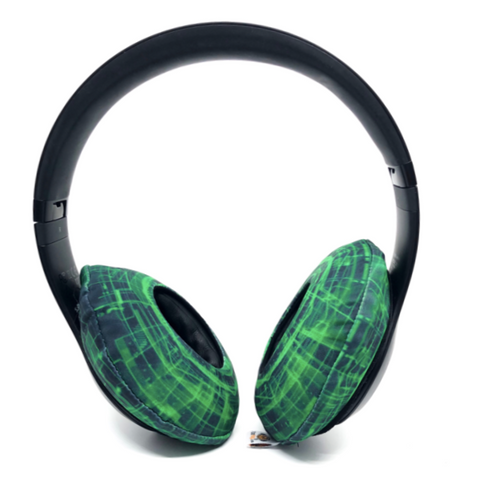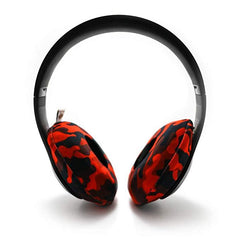How to Protect Your Headphones (Without Changing the Pads)

Our headphones go through a lot.
Think about it. Most of us wear them regularly. We put them over our heads throughout the day, hang them around our necks, keep them in our backpacks, drop them onto chairs and tables. We exercise in them. We fall asleep in them. It’s no wonder that they can quickly start showing their age, even when they’re not actually that old.
How we treat our headphones can accelerate damage, but the materials used by the manufacturer to make them will play a role, too.
We expect budget headphones to use synthetic materials, but you may be surprised to find that even more expensive brands use synthetic leather on their cushions. It’s worth checking what yours is made from. Most people assume it’s leather. Which is why peeling, or cracking cushions comes as a surprise to some people. It’s been reported by wearers of both Beats and Bose headphones. Synthetic leather isn’t necessarily a bad thing, but it’s not designed to last as long as leather or velour.
Next time you’re shopping for headphones, it’s worth paying attention to the materials used. Buying a pair with removable earpads is a good idea, but that’s not always an option nor will it guarantee that overall longevity for your cans.
Not everyone has the budget for a start. (Looking for affordable wireless headphones? We've just added some to our online store)
But what can you do to slow down the aging process? How can you protect your headphones without changing the pads?
How to Protect Your Headphones
Wipe the Cushions Down
You should get into the habit of regularly wiping down the headphone cushions when you’ve used them. This is especially true for anyone exercising or gaming in on-ear or over-ear headphones. Sweat that’s left to sit on the cushions will dry out and leave the earpads vulnerable to cracking and peeling. Using a microfiber cloth to wipe away should help reduce this happening. Anyone wearing make-up or with oily skin will also see the benefit in doing this as cushions can quickly become stained and look unsightly.
Some people add moisture to the cloth to lift off stubborn marks or to ensure the cushion remains fresh. Damping the cloth with water can help. You might also add a small amount of diluted soap to remove any oils on the surface of the cushion. Be sure to dry them thoroughly afterwards, though. Some people also use baby wipes. You might also like to try alcohol wipes to kill any bacteria and many people do, but we wouldn’t recommend doing this too regularly in case this degrades the material.
Leather cushions can benefit from a leather conditioner, but this should only be done once or twice a year and using a small amount of product. If in doubt, contact the manufacturer. Sennheiser for example, warns against the use of leather polish, detergents or harsh soaps. Check, too, the material you’re hoping to maintain as leather condition won’t work on synthetic materials. The trick, as always, is to be gentle and careful.
The benefit of removable headphone cushions is that they can be thoroughly washed without risking the internal electronics. When you’re not removing the earpads, it’s best to err on the side of caution and keep your clothes only lightly damp and your products in tiny amounts.
Buy Headphone Covers
Moisture-resistant headphone covers are a proactive approach to keeping your headphone protected from sweat and stains. They act as a fabric barrier between your ears and the cushions. Ideal if you’re exercising in headphones or if you’re gaming for many hours at a time. Sweat is one of the biggest threats to your cushions so the moisture-wicking fabric on them works in the same way as sweat-wicking performance wear: the moisture is moved to the surface of the material where it can then be quickly evaporated away from the headphone. This not only helps your headphones stay looking fresh, but they’ll smell fresher for longer, too. Months or years of sweat accumulating inside the cushions can lead to a horrendous (and embarrassing) smell.
Headphone covers are machine washable. They come in a range of colours and designs and are a great way of personalising your headphones without having to add a skin. What’s more, they’re super simple to add onto and take off the pads as well as being fully reversible.
Use the Case
Keep your headphone in a case when you’re not using them. This helps protect them from dust and UV light which can stain the cushions (especially if they’re white or cause them to crack. Using your headphones case will also help protect the headband, especially if you’re traveling.
Consider Buying Removable Cushions Next Time
If you do decide to remove your cushions, then you have several other ways of keeping them clean. Several forums recommend handwashing them in a gentle detergent, something like woolite, for example. Others say they’ve removed their pads and put them into the washing machine using a delicates bag to protect them in the drum. Although, this may not be suitable for all headphone cushions - especially cheaper ones. Ensuring that they’re dried properly before putting them back onto the headphones is very important.
Buying headphones will mean accepting the fact that there’s going to be wear and tear to the cushions over time. But that doesn’t mean that we just must accept that there’s nothing we can do. Wiping down the headphone cushions, adding headphone covers, keeping them out of the UV light and away from dust, and making use of headphone cases can all help ensure we’re able to enjoy our headphones for a long time to come.
For most people, the easiest options will be wiping down the cushions regularly, or buying headphone covers. We’re particularly enthusiastic about the second point.
Headphone covers are convenient and hygienic. They’re easy to put on and off and come in a range of designs and colours. For us, they represent an easy way to protect your headphones especially when you’re exercising. Check out the range on our website.






